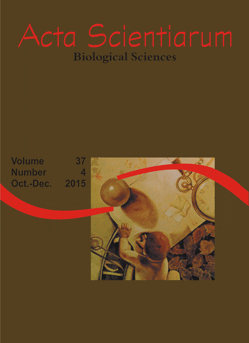<b>Pollen spectrum of the honey of uruçu bee (<i>Melipona scutellaris</i> Latreille, 1811) (Hymenoptera: Apidae) in the North Coast of Bahia State
Resumo
Regional-level studies of floral resources used by social bees for honey production can contribute to the improvement of management strategies for bee pastures and colonies, by identifying the most visited flowers and thus characterizing the various geographical origins of honey. The objective of this study was to investigate, through pollen analysis, the types of pollen and nectar sources used by the uruçu bee (Melipona scutellaris L.) in the North Coast of Bahia. Honey samples were taken monthly from five colonies in an apiary from August 2010 to July 2011. Pollen analysis of honey was performed by using the acetolysis method, followed by qualitative and quantitative analysis of pollen grains. Fifty pollen types belonging to 40 genera and 17 families were identified. The results indicate predominance of pollen types belonging to the families Fabaceae and Myrtaceae, which suggests that the bees preferred foraging from trees and shrubs. These plants should be included in regional reforestation projects in order to improve management of this bee species and honey production.
Downloads
DECLARAÇÃO DE ORIGINALIDADE E DIREITOS AUTORAIS
Declaro que o presente artigo é original, não tendo sido submetido à publicação em qualquer outro periódico nacional ou internacional, quer seja em parte ou em sua totalidade.
Os direitos autorais pertencem exclusivamente aos autores. Os direitos de licenciamento utilizados pelo periódico é a licença Creative Commons Attribution 4.0 (CC BY 4.0): são permitidos o compartilhamento (cópia e distribuição do material em qualqer meio ou formato) e adaptação (remix, transformação e criação de material a partir do conteúdo assim licenciado para quaisquer fins, inclusive comerciais.
Recomenda-se a leitura desse link para maiores informações sobre o tema: fornecimento de créditos e referências de forma correta, entre outros detalhes cruciais para uso adequado do material licenciado.












1.png)




3.png)













